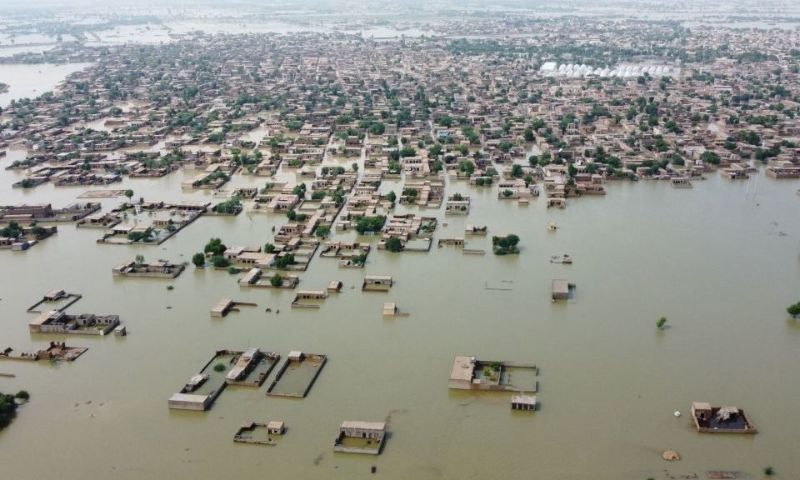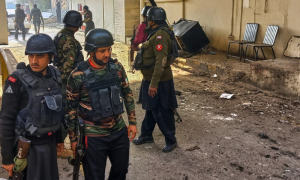KEY POINTS
- Pakistan issues “exceptionally high” flood alert after India releases water into Ravi and Sutlej rivers.
- Over 200,000 people evacuated across Punjab; 263 relief camps set up.
- Ravi, Sutlej and Chenab rivers at critical flood levels; dozens of villages inundated.
- Pakistan Army rescues 28,000 people, sets up 29 medical camps.
- PM Sharif orders urgent relief, while CM Maryam declares emergency in hospitals.
- More heavy rainfall forecast from August 29 to September 2.
LAHORE, Pakistan: Pakistan issued an “exceptionally high” flood alert on Wednesday after India released large volumes of water from its upstream dams into the Ravi and Sutlej rivers, forcing the evacuation of more than 200,000 people in Punjab province from flood-hit areas, authorities said.
Pakistan’s Flood Forecasting Division said that “very high to exceptional high flood levels” will continue in the Sutlej River at Ganda Singh Wala and downstream, Ravi River at Jassar and downstream, while high to very high flood levels are likely to continue in the nullahs of the Ravi and Chenab rivers within the next 24 hours.
According to the daily Federal Flood Commission (FFC) report on Wednesday, the Chenab River at Trimmu is expected to attain an exceptionally high flood level in the evening of August 29.
Similarly, the Chenab River at Panjnad (including discharges from Balloki and Islam) is expected to reach a very high flood level on September 2, 2025. The Indus River at Guddu and Sukkur is expected to attain very high flood levels on September 4 and 5, 2025.
Currently, the Indus River is flowing in low flood in Chashma-Taunsa-Guddu-Sukkur-Kotri reaches while the Chenab River run in very high flood with falling trend at Marala.
There is an “exceptionally high flood” with a rising trend at Khanki and Qadirabad, the flood forecast division stated.
Meanwhile, Deputy Commissioner Wasim of Multan, Waseem Hamid Sindhu, said the district administration had issued a red alert to tackle possible floods in the Chenab and Sutlej rivers.
Acting on the Punjab government’s direction, the evacuation of citizens from riverine areas had been accelerated. He said flood relief camps had been set up at Head Muhammad Wala, Bund Bosan, Sher Shah, and Jalalpur Pirwala.
Rescue efforts
The National Disaster Management Authority (NDMA) Chairman, Lieutenant General Inam Haider Malik, said that nearly 210,000 people have been relocated to safe places across Punjab, with no casualties reported so far.
NDMA Chairman Lieutenant General Inam Haider Malik said the evacuations were carried out in coordination with the Pakistan Army, Rangers, Rescue 1122, Provincial Disaster Management Authorities and other agencies.
Evacuees have been shifted to relief camps where they are receiving food, medical treatment and temporary shelter.
The NDMA Chairman warned that further rainfall is expected between August 29 and September 9, with rivers already running at critical levels.
Water flow at Panjnad is forecast to surge between 600,000 and 700,000 cusecs in the coming days.
Early warnings have been issued to authorities in Sindh and Punjab, while residents along the Chenab, from Qadirabad to Pindi Bhattian, have been urged to evacuate immediately.
Swelling rivers
The River Ravi is in “exceptionally high flood” following India’s release of 200,000 cusecs of water.
At Jassar, the flow has risen to nearly 230,000 cusecs, threatening low-lying areas of Lahore and parts of the motorway linking the city to Islamabad.
In Narowal, floodwaters entered the Kartarpur Corridor, submerging the revered Sikh shrine under five to seven feet of water. Roads to Shakargarh have also been cut off.
Floods Update in Pakistan 🇵🇰 🚨
Flood waters enter in Gurudwara Kartarpur Sahib in Pakistan as Ravi overflows.
As of now –
800+ Deaths
114 Bodies found
116 Bridges Damaged
7465+ Houses Destroyed1,50,000+ people evacuated after India’s warning#CloudBurst #Rain #JammuKashmir pic.twitter.com/GOU8fMZfe8
— Mayank (@mayankcdp) August 27, 2025
In the Sutlej River, flows at Head Ganda Singh Wala have reached 245,000 cusecs, inundating dozens of villages in Bahawalnagar, Pakpattan and Arifwala.
More than 100 villages have been affected, with thousands of people and livestock moved to higher ground. Authorities reported that 30 villages in border areas remain underwater.
The River Chenab is also experiencing extreme flooding. At Head Khanki, flows have exceeded 700,000 cusecs, while Chenab Nagar and Kot Momin face severe pressure.
District officials have declared a critical flood emergency, with relief camps established and the army assisting with evacuations.
Separately, an “exceptionally high” flood level was recorded in Nullah Dek near Pasrur, where a surge of 77,000 cusecs swept away a key bridge and inundated dozens of villages.
Pakistan Army continues rescue efforts
Meanwhile, Pakistan Army troops have rescued more than 28,000 people from flood-hit areas.
Director General of Inter-Services Public Relations (ISPR), Lieutenant General Ahmed Sharif Chaudhry, said that one engineer brigade and 19 infantry and medical units are deployed across Punjab, Khyber Pakhtunkhwa, Gilgit-Baltistan and Azad Jammu and Kashmir.
He said 29 army medical camps have treated over 20,000 patients, while 225 tonnes of food supplies have been distributed.
Lieutenant General Chaudhry said that two soldiers were killed and two others injured during relief operations.
“These brave soldiers were operating in difficult terrain and severe weather conditions,” he said, adding that the army remains committed to supporting citizens in their hour of need.
Punjab Rangers are also leading operations in border regions, evacuating nearly 7,000 people and more than 1,000 livestock in Kasur district alone.
PM orders urgent measures
Meanwhile, Prime Minister Shehbaz Sharif chaired a high-level meeting on Wednesday, directing federal ministers to oversee relief efforts in the hardest-hit districts.
He instructed authorities to ensure uninterrupted power, restore roads and communications, and prepare for possible urban flooding in Gujrat, Sialkot and Lahore.
PM Sharif praised the NDMA for timely warnings, which he said had helped avert major loss of life, and ordered preventive measures to protect crops and livestock. He reaffirmed that rehabilitation of flood victims remains a national priority.
Punjab Chief Minister Maryam Nawaz has also declared an emergency across all provincial hospitals, cancelling staff leave and ordering 24-hour readiness.
She said 263 relief camps and 161 medical camps are operating across Punjab, supporting more than 600,000 affected people. Over 150,000 individuals and 35,000 livestock have been relocated to safer areas.
“For the first time in nearly four decades, Punjab is facing simultaneous flooding in three rivers,” she said after inspecting the Ravi River bridge. “The rehabilitation of every flood-affected family is my mission.”
More rain expected
Meanwhile, the Pakistan Meteorological Department has forecast another spell of heavy rainfall from 29 August to 2 September across Punjab, Khyber Pakhtunkhwa, Azad Kashmir and Gilgit-Baltistan.
The weather department has warned of flash floods in local streams and urban flooding in cities including Lahore, Sialkot, Faisalabad, Islamabad and Peshawar.
























